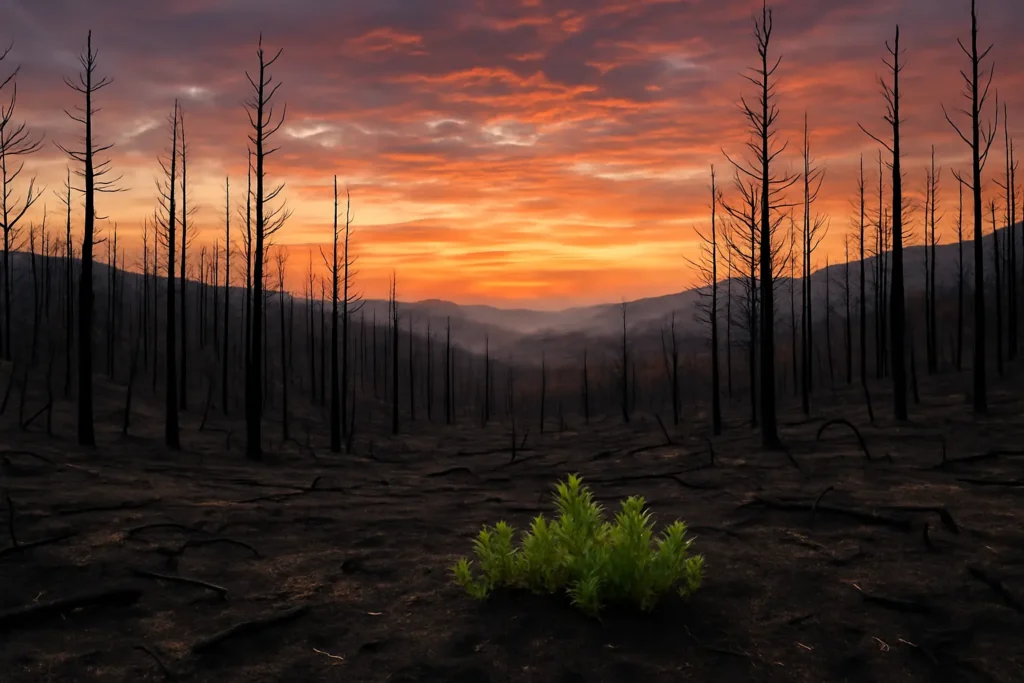Catastrophe in the Golden State: The Gifford Fire’s Relentless March
As the Gifford Fire explodes into California’s largest inferno of 2025—now eclipsing 104,000 scorched acres—residents across San Luis Obispo and Santa Barbara counties find their lives upended, evacuation bags packed, and nerves worn raw by an ever-more familiar disaster. This is not some remote event; it is a blunt signal of the climate crisis’s presence here and now. The images from Los Padres National Forest—dense smoke drifting over parched hills, walls of flame licking at rural homes, and exhausted firefighters standing in soot-caked silence—echo a state that has grown weary of annual catastrophe.
The Gifford Fire’s origins are as chaotic as the blaze itself: a cluster of at least four smaller wildfires that erupted along State Route 166, swiftly merging into one out-of-control spectacle. With relentless triple-digit heat gripping the region, vast swathes of brush—never allowed to recover amid years of drought—became tinder waiting to ignite. More than 870 homes, ranches, and outbuildings on the forest’s northern edge remain in peril as the fire advances through rugged canyons and chaparral. The situation is dire enough that the U.S. Forest Service has closed off public access to significant stretches of the Los Padres National Forest through February, restricting not just resupply lines, but recreational, cultural, and economic lifeblood for communities already battered by disaster.
It’s telling—and damning—that this kind of event is no longer an aberration for California. The nomenclature has shifted. We now speak regularly of “megafires,” and the term, once reserved for the truly rare, is now part of the state’s annual lexicon. According to the U.S. Interagency Fire Center, a so-called “megafire” is one surpassing 100,000 acres. The Gifford blaze reached that threshold with little fanfare, simply the latest chapter in a cycle of escalating loss.
Climate Change: From Distant Threat to Urgent Reality
Across the firelines, more than 2,200 firefighters are locked in a grueling, day-and-night battle against an enemy all too familiar—and, in many ways, enabled by policy and climate neglect. Extreme heat waves are not a fluke; they are an engineered result of human choices, especially in energy and land management. The fingerprints of climate change are all over California’s megafires. Consider this: According to the National Oceanic and Atmospheric Administration (NOAA), the last decade has seen five of the six largest wildfires in state history. In real time, we witness the deserts expanding, forests drying, and seasonal rains shrinking to unpredictable intervals.
Harvard climate scientist Dr. Leah Stokes points to a double bind: “Western states are entering a regime of more rapid, intense drying. When the spark ignites, there’s simply too much fuel—dead trees, shrubs, grass. Add record-breaking heat, and the very landscape is primed for disaster.” The Gifford Fire’s aggressive spread, burning on both sides of Highway 166, lays bare this peril: once a blaze takes hold in terrain this parched and inaccessible, containment becomes nearly impossible. Evacuation zones have swelled to nearly 800 square miles, and while 21 percent containment offers hope, much can change with the next weather shift.
Is this the “new normal”—or, as many scientists now argue, only the beginning of climate destabilization’s impact on infrastructure, ecosystems, and the social fabric?
“We are living in the era we were warned about. The cost of inaction—political, economic, and moral—surrounds us in the form of megafires, lost homes, and shattered communities.”
— Dr. Leah Stokes, Harvard University
As Los Padres National Forest endures fire restrictions and closures, the local economy takes a hit—tourist dollars dry up, neighboring towns lose revenue, and residents find their access to public lands, and even basic services, severely curtailed. The toll extends far beyond the immediate loss of wildlife or acreage; it eats into the heart of community resilience.
A Political Pyre: Policy Failures, Environmental Justice, and the Road Ahead
Some may ask: Why, after all this devastation, does it seem we are still unprepared? Conservative policies and continued resistance to bold climate action are complicit in keeping the cycle unbroken. Time after time, efforts at substantial forest and land management reform stall on the floors of Congress, often due to industry lobbying or climate denial rhetoric. Meanwhile, firefighting budgets strain to keep pace, and disaster relief arrives too late for families who have already lost everything.
The Gifford Fire exposes deeper fault lines— those affecting rural, often lower-income communities that face disproportionate impacts from wildfire, water scarcity, and air pollution. As evacuation orders widen, they highlight existing inequalities in disaster preparedness and recovery. The struggle here is not just against flames or weather, but against systemic neglect and the tendency to treat wildfires as isolated acts of nature rather than the predictable outcome of failed governance and deregulation.
What could meaningful progress look like? According to a 2023 Pew Research Center study, a strong majority of Americans favor more funding for wildfire mitigation, including prescribed burning, reforestation, and modernized firefighting infrastructure. States like California have passed aggressive emissions standards and invested in early warning systems, but these are piecemeal solutions. National coordination, robust climate adaptation, and direct investment in vulnerable communities are needed—bold commitments, not half-measures.
The fate of those 2,912 threatened structures—homes, schools, businesses—hangs in the balance, subject to the whims of weather and the strength of exhausted crews on the ground. Yet the deeper truth is that each season’s record-breaking blaze is not inevitable, but rather the consequence of choices, both past and present. As the Gifford megafire burns, so too does the opportunity to confront the causes and enact change, lest this year’s disaster simply becomes next year’s baseline.
For Californians—and for Americans everywhere—the story is no longer simply about one terrible fire, but about the urgent call to reshape our future, bring justice to the margins, and demand accountability where too often silence and denial have prevailed.

